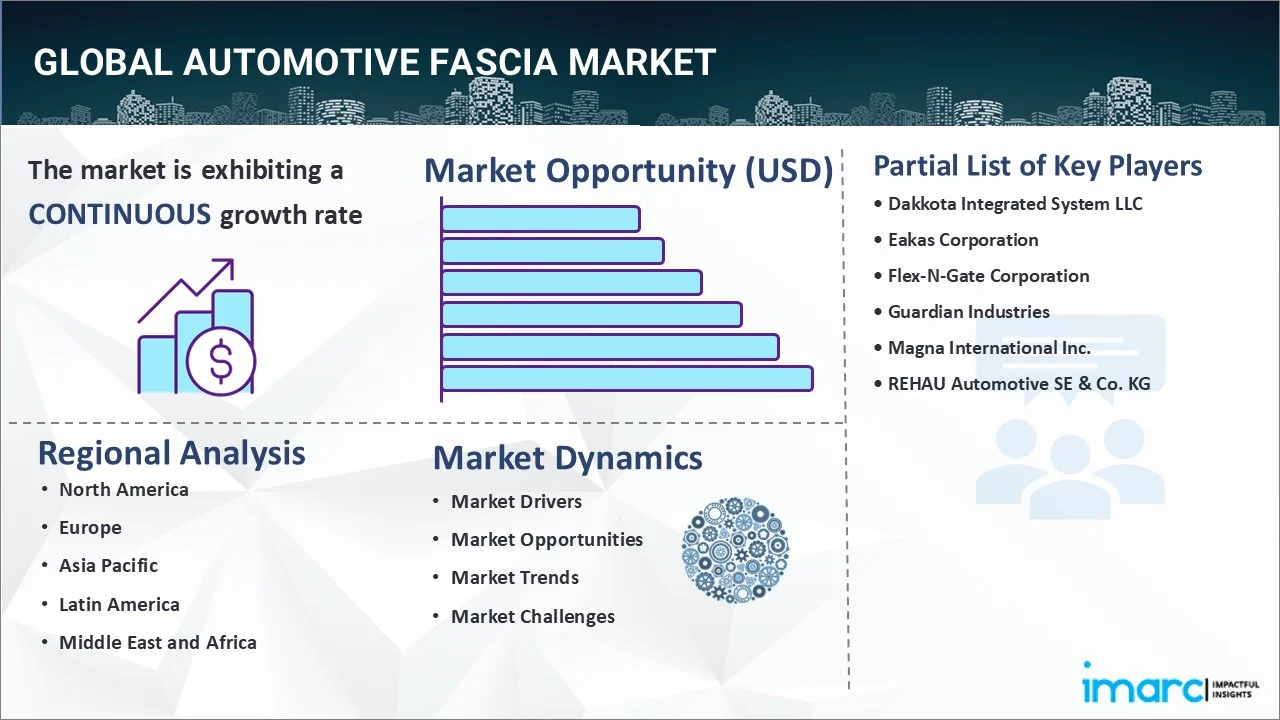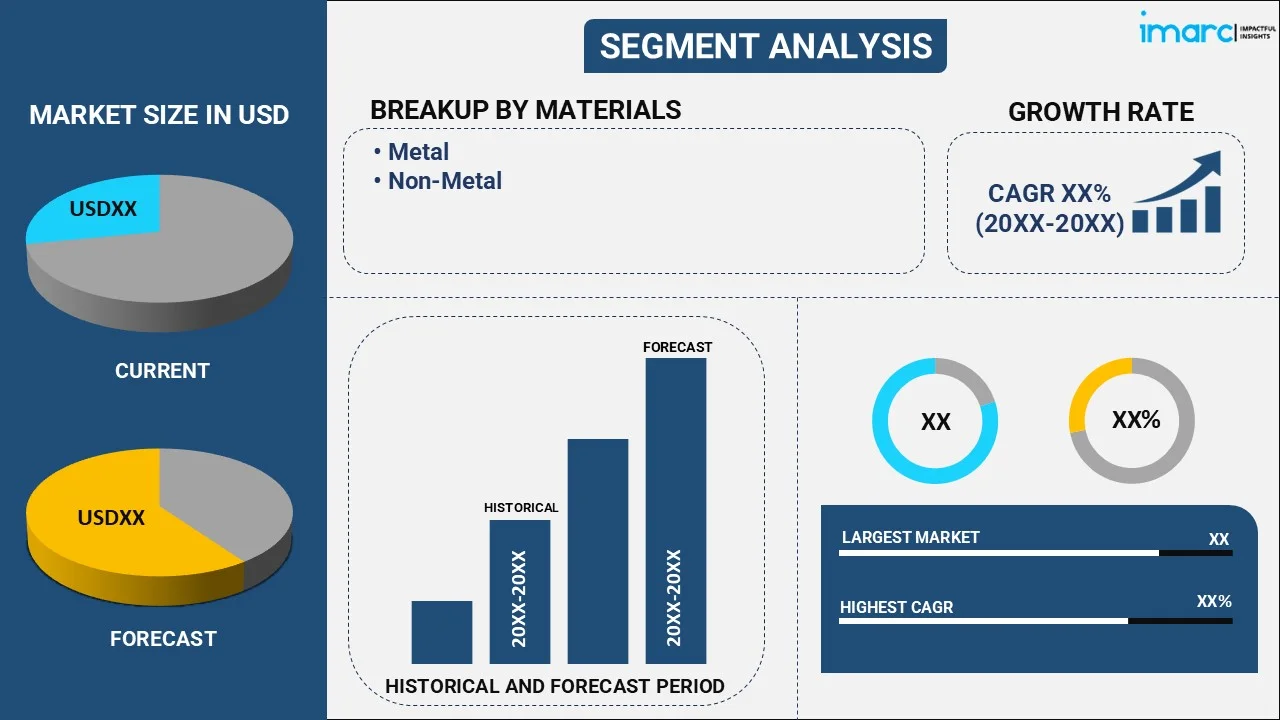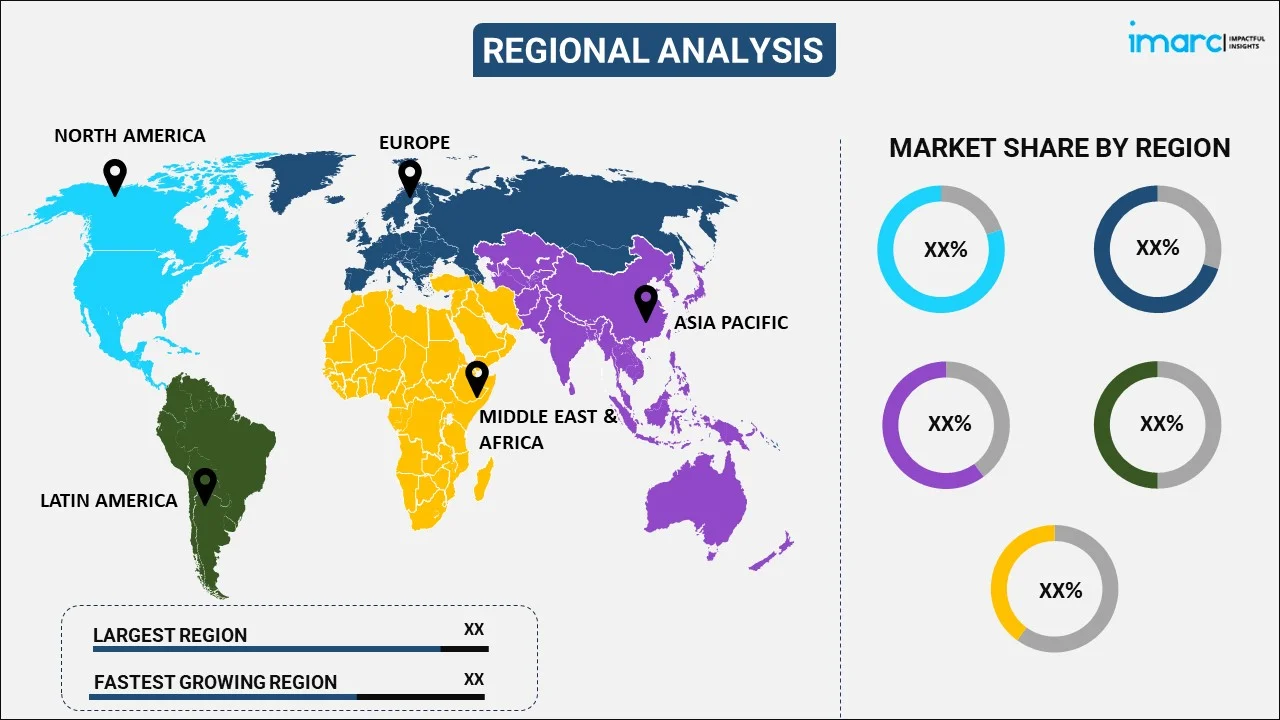
Automotive Fascia Market Report by Material (Metal, Non-Metal), Position Type (Front Fascia, Rear Fascia), Vehicle Type (Passenger Cars, Commercial Vehicle), Sales Channel (OEM, Aftermarket), and Region 2025-2033
Market Overview:
The global automotive fascia market size reached USD 16.0 Billion in 2024. Looking forward, IMARC Group expects the market to reach USD 25.8 Billion by 2033, exhibiting a growth rate (CAGR) of 5.44% during 2025-2033. The implementation of stringent regulations on the vehicles, the increasing sales of automobiles, and the rapid expansion of the automotive sector across the globe are some of the major factors propelling the automotive fascia market.
|
Report Attribute
|
Key Statistics
|
|---|---|
|
Base Year
|
2024 |
|
Forecast Years
|
2025-2033
|
|
Historical Years
|
2019-2024
|
| Market Size in 2024 | USD 16.0 Billion |
| Market Forecast in 2033 | USD 25.8 Billion |
| Market Growth Rate 2025-2033 | 5.44% |
The automotive fascia refers to the front end of a vehicle, including the bumper, grille, headlights, and other aesthetic and functional components that define its visual identity. It serves as the face of the vehicle, showcasing its brand identity and design language. The fascia not only plays a crucial role in protecting the vehicle's underlying components but also contributes to its aerodynamics and overall performance. The bumper, which is normally constructed of durable materials including plastic or metal, is intended to absorb impact energy in the case of a collision, protecting the important parts behind it, including the cooling system and engine. The grille, positioned in the center of the fascia, allows airflow to reach the engine for cooling and often showcases the automaker's logo or emblem. The headlights, positioned on either side of the grille, provide illumination for safe driving at night or in adverse weather conditions.

Significant growth in the automotive industry majorly drives the global market. Coupled with the widespread adoption of automotive fascia in the manufacturing of automobiles is providing a boost to the market. Moreover, automotive fascia plays a significant role in the overall design and aesthetics of a vehicle. Consumer preferences for sleek, aggressive, and modern designs have driven automakers to enhance the appearance of fascia components. Distinctive grille designs, signature LED headlights, and aerodynamic shapes have become popular trends in the automotive industry, this is acting as a growth-inducing factor. Furthermore, the automotive fascia serves as a branding element for manufacturers. The front-end design often reflects the brand's identity and creates a recognizable visual appeal, thereby creating a positive market outlook. Other factors, including the increasing investment in road connectivity and the extensive adoption of personal cars among the masses, are also positively influencing the market.
Automotive Fascia Market Trends/Drivers:
Enhanced preference for safety regulations
Stringent safety regulations imposed by governments and regulatory bodies across the globe have been significant drivers for the automotive fascia market. Front-end modules are designed to absorb impact and protect occupants in the event of a collision. Automakers are continuously investing in research and development to improve the crashworthiness of vehicles, leading to the adoption of advanced materials, such as high-strength steel, aluminum, and composites, in the construction of fascia components. Additionally, the rising popularity of electric vehicles is another important market driver for automotive fascia. EVs have unique design requirements due to their aerodynamic needs and the absence of traditional internal combustion engine components, which is acting as another growth-inducing factor. With the increasing adoption of electric mobility, the demand for specialized fascia components for EVs is expected to gain prominence across the globe.
Increased demand for lightweight and fuel efficient vehicles
The automotive industry is increasingly focused on reducing the weight of vehicles to enhance fuel efficiency and reduce emissions. Lightweight materials, such as plastics, carbon fiber, and aluminum, are being utilized in fascia construction to achieve weight savings. Lightweight fascia components contribute to improved aerodynamics, reduced energy consumption, and enhanced overall vehicle performance, which is positively influencing the market. In addition, automotive manufacturers are emphasizing the visual appeal of vehicles to attract customers. Consumers are demanding stylish, innovative, and customizable front-end modules, which is encouraging automakers to invest in advanced manufacturing processes, including injection molding, 3D printing, and painting techniques, to create intricate and visually appealing fascia designs is also contributing to the market.
Continual technological advancements
The integration of advanced technologies with automotive fascia is catalyzing the demand for automotive fascia. Automakers are incorporating sensors, cameras, and adaptive lighting systems into the front-end modules for advanced driver-assistance systems (ADAS) and autonomous driving features. These technologies enhance vehicle safety, provide improved visibility, and enable functions, such as lane departure warnings, automatic emergency braking, and pedestrian detection, thus driving the demand for intelligent and sensor-rich fascia designs. Automotive fascia plays a pivotal role in offering design flexibility, enabling automakers to cater to individual preferences and market trends. Modular fascia designs allow for easy integration of different grille styles, lighting arrangements, and aesthetic features, providing consumers with options to create a unique appearance for their vehicles, thereby propelling the market.
Automotive Fascia Industry Segmentation:
IMARC Group provides an analysis of the key trends in each segment of the global automotive fascia market report, along with forecasts at the global, regional, and country levels for 2025-2033. Our report has categorized the market based on material, position type, vehicle type and sales channel.
Breakup by Material:

- Metal
- Steel
- Aluminum
- Non-Metal
- Polypropylene
- ABS
- Rubber
- Polycarbonate
- Others
Non-metal dominates the market
The report has provided a detailed breakup and analysis of the automotive fascia market based on the material. This includes metal (steel, and aluminum), and non-metal (polypropylene, ABS, rubber, polycarbonate, and others). According to the report, non-metal represented the largest segment.
The increasing emphasis on lightweight vehicles to enhance fuel efficiency and reduce carbon emissions is driving the demand for non-material. Non-metal materials, such as high-performance plastics, composites, and polymers, offer substantial weight savings over traditional metal counterparts while maintaining structural integrity and durability. This weight reduction not only improves the overall fuel efficiency of vehicles but also enhances handling, performance, and agility, which is acting as a growth-inducing factor.
Along with this, the widespread adoption of non-metal materials as they provide automotive designers with a wide range of possibilities for creating innovative and visually appealing fascia designs is significantly supporting the market.
On the other hand, metal, particularly steel and aluminum alloy, offers high strength and durability, making it ideal for automotive fascia components. Metal fascia can withstand impact and provide protection in case of collisions or accidents, ensuring the safety of both the vehicle and its occupants.
Breakup by Position Type:
- Front Fascia
- Rear Fascia
Front fascia represents the leading position
A detailed breakup and analysis of the automotive fascia market based on the position type has also been provided in the report. This includes front fascia and rear fascia. According to the report, front fascia accounted for the largest market share.
The front fascia of a vehicle is a crucial component that not only defines its aesthetic appeal but also plays a significant role in terms of functionality and safety. It encompasses various elements that come together to create the face of the vehicle, giving it a distinctive identity and character. The front fascia typically includes the grille, headlights, bumper, air intake, and other design elements.
On the other hand, the rear fascia refers to the rear section of a vehicle's exterior, specifically the area encompassing the rear bumper, taillights, and any additional styling elements. It plays a crucial role in enhancing the aesthetics, functionality, and safety of the vehicle. In terms of aesthetics, the rear fascia contributes to the overall design and visual appeal of the vehicle. It is often designed to complement the front fascia and other exterior elements, creating a cohesive and balanced appearance.
Breakup by Vehicle Type:
- Passenger Cars
- Commercial Vehicle
Passenger cars dominate the market
The report has provided a detailed breakup and analysis of the automotive fascia market based on the vehicle type. This includes passenger cars and commercial vehicle. According to the report, passenger cars represented the largest segment.
Consumers are increasingly seeking passenger cars that offer advanced infotainment systems, intuitive controls, and seamless integration with smartphones and other devices. Additionally, the growing emphasis on sustainability and environmental consciousness is positively influencing the market. As concerns about climate change and air pollution continue to rise, there is a growing demand for electric and hybrid passenger cars. This shift towards eco-friendly transportation is leading to the development of sleek and futuristic fascia designs that reflect the modern and environmentally conscious image.
Commercial vehicles, such as trucks and vans, require more robust and functional fascia designs compared to passenger vehicles. The front-end components of commercial vehicles need to withstand heavy-duty usage, including hauling cargo, navigating challenging terrains, and enduring potential impacts. As a result, the automotive fascia market for commercial vehicles often focuses on durable materials, reinforced structures, and practical design features that enhance functionality.
Breakup by Sales Channel:
- OEM
- Aftermarket
OEM represents the leading sales channel segment
A detailed breakup and analysis of the automotive fascia market based on the sales channel has also been provided in the report. This includes OEM and aftermarket. According to the report, OEM represented the largest segment.
The implementation of stringent government regulations and standards concerning safety and emissions have been instrumental in driving innovation and technological advancements in the industry. OEMs are constantly striving to develop fascia systems that not only enhance the aesthetic appeal of vehicles but also incorporate features that improve pedestrian safety, aerodynamics, and overall fuel efficiency. Moreover, the increasing consumer demand for personalized and customized vehicles has driven the OEM segment to offer a wide range of fascia options, materials, and designs.
As the number of older vehicles continues to rise, the demand for replacement parts and accessories for automotive fascias grows. Older vehicles often require repairs or upgrades to their fascias due to wear and tear, accidents, or changes in aesthetics. This creates a substantial market for aftermarket fascia components. In addition, the demand for customization and improved aesthetics fuels the aftermarket industry as manufacturers and suppliers strive to offer a wide range of options to cater to individual preferences.
Breakup by Region:

- North America
- United States
- Canada
- Europe
- Germany
- France
- United Kingdom
- Italy
- Spain
- Others
- Asia Pacific
- China
- Japan
- India
- South Korea
- Australia
- Indonesia
- Others
- Latin America
- Brazil
- Mexico
- Others
- Middle East and Africa
Asia Pacific exhibits a clear dominance, accounting for the largest automotive fascia market share
The report has also provided a comprehensive analysis of all the major regional markets, which include North America (the United States and Canada); Europe (Germany, France, the United Kingdom, Italy, Spain, and others); Asia Pacific (China, Japan, India, South Korea, Australia, Indonesia, and others); Latin America (Brazil, Mexico, and others); and the Middle East and Africa.
Asia Pacific held the biggest market share due to the rising demand for vehicles in the region. Asia Pacific has witnessed a significant rise in disposable incomes and the growing middle-class population, leading to higher consumer spending on automobiles. This is driving the vehicle sales and has directly translated into higher demand for automotive fascia components.
Furthermore, stringent government regulations and safety standards have become crucial drivers for the automotive fascia industry. Governments in the Asia Pacific region are implementing strict regulations pertaining to vehicle safety and pedestrian protection. As a result, automotive manufacturers are compelled to incorporate advanced safety features into their vehicles, including robust fascia systems. This is driving the demand for technologically advanced and impact-resistant fascia components.
North America is estimated to expand further in this domain during the forecast period. This can be attributed to the increasing consumer demand for advanced safety features and improved aesthetics in vehicles. As customers become more conscious about safety and seek an enhanced visual appeal, automakers are compelled to design and manufacture vehicles with sleek, modern, and functional fascia systems.
Competitive Landscape:
The global automotive fascia market is experiencing steady growth across the globe with the growing investment by leading players in aesthetic enhancements and customization options in vehicles. Additionally, top companies are focusing on safety regulations and pedestrian protection that has created a demand for advanced fascia designs that incorporate pedestrian impact absorption systems. Furthermore, the introduction of electric vehicles and autonomous driving technologies by key players has opened up new possibilities for innovative fascia designs and the incorporation of features, such as integrated sensors, cameras, and communication modules. As the automotive industry continues to evolve, the market opportunities for automotive fascia’s manufacturers are expected to expand, offering avenues for technological advancements, improved functionality, and enhanced design options.
The report has provided a comprehensive analysis of the competitive landscape in the global automotive fascia market. Detailed profiles of all major companies have also been provided. Some of the key players in the market include:
- Dakkota Integrated System LLC
- Eakas Corporation
- Flex-N-Gate Corporation
- Guardian Industries
- Magna International Inc.
- REHAU Automotive SE & Co. KG
Recent Developments:
- Dakkota Integrated Systems has announced its intention to build and operate a manufacturing facility to produce suspension assemblies and instrument panel assemblies in support of FCA's production of the Jeep Grand Cherokee and Jeep Grand Wagoneer.
- Magna International Inc. has recently introduced rear thermoplastic swing doors that are manufactured using recycled materials, which are lighter than traditional steel solutions in an attempt to minimize the overall weight of the vehicle while reducing the opening effort for consumers. Moreover, the utilization of thermoplastic resin material grants vehicle designers’ greater flexibility in styling, allowing for more intricate detailing, distinct undercut surfaces, and tighter radii. This enhanced freedom enables enhanced brand differentiation within the automotive industry.
- REHAU Automotive SE & Co. KG have recently partnered with ZKW, lighting system specialist company to promote the incorporation of modern lighting systems in vehicle fronts and to offer future-oriented solutions to their customers.
Automotive Fascia Market Report Scope:
| Report Features | Details |
|---|---|
| Base Year of the Analysis | 2024 |
| Historical Period | 2019-2024 |
| Forecast Period | 2025-2033 |
| Units | Billion USD |
| Scope of the Report | Exploration of Historical Trends and Market Outlook, Industry Catalysts and Challenges, Segment-Wise Historical and Predictive Market Assessment:
|
| Materials Covered |
|
| Position Types Covered | Front Fascia, Rear Fascia |
| Vehicle Types Covered | Passenger Cars, Commercial Vehicle |
| Sales Channels Covered | OEM, Aftermarket |
| Regions Covered | North America, Europe, Asia Pacific, Latin America, Middle East and Africa |
| Countries Covered | United States, Canada, Germany, France, United Kingdom, Italy, Spain, China, Japan, India, South Korea, Australia, Indonesia, Brazil, Mexico |
| Companies Covered | Dakkota Integrated System LLC, Eakas Corporation, Flex-N-Gate Corporation, Guardian Industries, Magna International Inc., REHAU Automotive SE & Co. KG, etc. |
| Customization Scope | 10% Free Customization |
| Post-Sale Analyst Support | 10-12 Weeks |
| Delivery Format | PDF and Excel through Email (We can also provide the editable version of the report in PPT/Word format on special request) |
Key Questions Answered in This Report:
- How has the global automotive fascia market performed so far, and how will it perform in the coming years?
- What are the drivers, restraints, and opportunities in the global automotive fascia market?
- What is the impact of each driver, restraint, and opportunity on the global automotive fascia market?
- What are the key regional markets?
- Which countries represent the most attractive automotive fascia market?
- What is the breakup of the market based on the material?
- Which is the most attractive material in the automotive fascia market?
- What is the breakup of the market based on the position type?
- Which is the most attractive position type in the automotive fascia market?
- What is the breakup of the market based on the vehicle type?
- Which is the most attractive vehicle type in the automotive fascia market?
- What is the breakup of the market based on the sales channel?
- Which is the most attractive sales channel in the automotive fascia market?
- What is the competitive structure of the global automotive fascia market?
- Who are the key players/companies in the global automotive fascia market?
Key Benefits for Stakeholders:
- IMARC’s report offers a comprehensive quantitative analysis of various market segments, historical and current market trends, market forecasts, and dynamics of the automotive fascia market from 2019-2033.
- The research study provides the latest information on the market drivers, challenges, and opportunities in the global automotive fascia market.
- The study maps the leading, as well as the fastest-growing, regional markets. It further enables stakeholders to identify the key country-level markets within each region.
- Porter's five forces analysis assist stakeholders in assessing the impact of new entrants, competitive rivalry, supplier power, buyer power, and the threat of substitution. It helps stakeholders to analyze the level of competition within the automotive fascia industry and its attractiveness.
- Competitive landscape allows stakeholders to understand their competitive environment and provides an insight into the current positions of key players in the market.
Need more help?
- Speak to our experienced analysts for insights on the current market scenarios.
- Include additional segments and countries to customize the report as per your requirement.
- Gain an unparalleled competitive advantage in your domain by understanding how to utilize the report and positively impacting your operations and revenue.
- For further assistance, please connect with our analysts.
 Request Customization
Request Customization
 Speak to an Analyst
Speak to an Analyst
 Request Brochure
Request Brochure
 Inquire Before Buying
Inquire Before Buying




.webp)




.webp)












